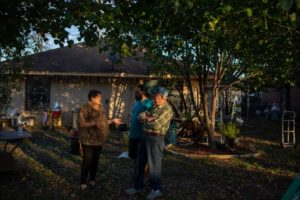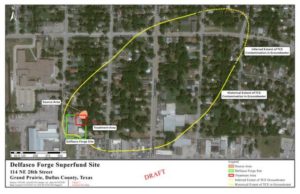From KERA:
The Beltrán family always stocks two to three cases of bottled water in the cluttered garage of their home in Grand Prairie. They’ve used it to drink and cook for 15 years, and they trek to the nearest Walmart to stay fully stocked.
“Nosotros llegamos aquí y el agua estaba salada, súper salada. Nosotros compramos garrafones de agua para cocinar,” Santa Barbara Beltrán, 72, said in Spanish. “We got here and the water was salty, super salty. We buy jugs of water for cooking.”
Her family has lived in Grand Prairie, west of Dallas, for over 30 years,. She said it’s a common belief among her neighbors that Grand Prairie’s water is not safe to drink because “contamination floods the streets of the neighborhood.”
Beltrán said she knew nothing about the Superfund toxic waste site two blocks away. But it’s possible the talk she’d heard for years about contaminated water wasn’t about Grand Prairie’s drinking water, but referred to a plume of highly polluted groundwater that’s spread beneath the neighborhood.

The Beltrán family do not use tap water to cook due to the water’s contamination. Instead, they buy jugs of portable water every week.
Keren Carrión / KERA News
The Environmental Protection Agency added the Superfund site, once occupied by a company called Delfasco Forge, to the National Priorities List in 2018. That ranked it as one of “the nation’s most serious uncontrolled or abandoned hazardous waste sites.” Tests showed that trichloroethylene (TCE), a highly toxic chemical used to clean machinery, had contaminated soil at the site, seeped into the groundwater and vaporized into the air from the groundwater plume. That affected about 80 homes in the neighborhood.
The EPA placed Delfasco Forge on the NPL more than three years ago. But EPA documents show that it still lacks data on whether the human health threat is under control and has been unable to mitigate the groundwater contamination.
KERA knocked on more than two dozen doors in the predominantly Latino, low-income neighborhood of Burbank Gardens and conducted extensive interviews with residents. Most knew nothing about the superfund site or the ongoing health threat.

The abandoned Delfasco Forge company site in Grand Prairie is contaminated. The toxic site has bled into the groundwater and soil and releases fumes into the air that if ingested can lead to respiratory diseases, neurological defects and cancer.
Keren Carrión / KERA News
Delfasco Forge, a defense contractor, manufactured military suspension lugs used to attach weapons to aircraft bomb racks on the 1.25-acre site from 1980 to 1998. The company declared bankruptcy in 2008, in part because of liabilities related to the cleanup.
Operators at Delfasco Forge used TCE to clean machinery and then simply drained into the soil. The EPA commissioned a study to assess the environmental impact. EA Engineering, Science, and Technology, Inc., found that “a review of building drawings indicate open pits may have been present in the shop building…and that these pits were connected to floor drains….”
Inhalation exposure to trichloroethylene can lead to respiratory diseases, neurological effects like dizziness, headaches, confusion, depression and cancer. A 2009 study by the Texas Department of State Health Services and the Texas Environmental Health Institute found a high correlation between indoor air levels of TCE and TCE in the blood of residents living in those homes, according to the EA Engineering report.
Beltrán’s home is tucked away in Burbank Gardens. Like many communities of color, it’s near a landfill, multiple industrial facilities — and the Superfund site.
Her family could hear a hammering noise that would come from Delfasco Forge during the day after they first moved in. The noise came from a hammer forge that made the suspension lugs.

The undocumented Mexican couple is in their 70s and live with Roy, their 44 year old son who has Lupus.
Keren Carrión / KERA News
Beltrán said she heard about the site’s contamination once 10 years ago, but her knowledge is very limited. Like many undocumented immigrants who fear deportation, she is wary about talking with government officials. She said she’s never talked directly to anyone from the EPA, even though she’s concerned about her health and safety.
“Te imaginas la continua contaminación que hay en la tierra por los químicos de las fábricas de allá atrás, pero como yo no sé inglés, lo entiendo poco, no puedo movilizaron,” Beltrán said in Spanish. “Can you imagine the continuous contamination on the soil by chemicals from factories. But since I don’t know English, I understand little,” she said. “I felt like I couldn’t mobilize.”
Feeling powerless, Beltrán now wonders if the site’s contamination may be linked to a couple of cancer cases on her block. She wonders, too, whether it may be related to her son’s illness. Roy, 44, has been diagnosed with lupus.
“Yo lo que sé que ha habido mucha gente con cáncer por esta calle,” Beltran said in Spanish. “I know that there have been many people with cancer on this street.”
A polluted history
Cindy Mendez, Grand Prairie’s director of public health and environmental quality, said environmental protections were limited after the site closed in the late 1990s.
“People really didn’t know what the hazards were with a lot of these chemicals that they were using,” she said.

An EPA aerial image shows the proximity James Fannin Middle School is to the Superfund site. The area circled is identified as impacted by the site.
The Texas Commission on Environmental Quality first detected soil and groundwater contamination at the site in 2002. The agency detected TCE and numerous other toxic chemicals that can vaporize. Responding to the contamination became a top priority for the TCEQ because many residents living in older homes relied on groundwater wells for their drinking water.
Mendez said state environmental agencies tried to remove the chemicals from the soil and groundwater. But technology at the time was not effective.
The EPA stepped in in 2008 and conducted further studies that found extensive contamination by TCE in the soil at the site and in the groundwater migrating beneath the neighborhood. Vapor containing TCE from the soil and groundwater also was detected inside residents’ homes.
Chris Villarreal, the EPA’s Texas section chief for the Superfund and Emergency Management Division, said exposure to contaminants from the site now comes from “what we refer to as vapor intrusion.” Delfasco Forge was, in fact, one of the first two sites in the country added to the National Priorities List for vapor intrusion.
Villareal said TCE levels in the neighborhood exceeded the EPA’s regional screening thresholds for potential cancer impact.
Studies in 2019 also found that TCE evaporates from the groundwater, enters through the soil, seeks or finds an airway escape and goes into people’s homes causing indoor air contamination of the residential properties adjacent to the former facility.
The EPA concluded that 81 homes needed vapor systems to clean the air, — but only 34 homes received those systems in 2014. Funds from the bankruptcy settlement paid for them.
Tests of those systems, also in 2014, produced “mixed results” with some samples showing “lower and some showing higher concentrations” of TCE in the air, the EA Engineering report said.
“There’s been several outreach attempts. We’ve had several public meetings in the neighborhood,” Mendez said. “All of our education is … bilingual and our meetings are done in a bilingual setting.”

An abandoned well is left outside of a resident’s home in Grand Prairie. Many wooden homes can be seen near the location of the Delfasco Forge site.
Keren Carrión / KERA News
George Craig, 58, wooden frame house is five minutes from the site. He said there is always a “funny smell” in and around his home.
“It’s almost like somebody puts on too much perfume and it’s really strong when you first smell it,” Craig said.
Craig is one of many neighborhood residents who had a groundwater well on their properties. The city informed him not to use the well water because of the TCE contamination.
“I’ve been here 20 years and I’ve never been able to use it,” he said.
Craig said he didn’t understand the extent of the contamination or what it meant, but he was among the residents who agreed to have vapor systems installed in their homes.
Craig said lightning struck and “blew up my stuff in my house” about five years ago — including the vapor system. Craig said he tried calling the city, but couldn’t get through. Since then, the vapor system hasn’t been fixed, and no one has checked in to see if it is working.

Students at James Fannin Middle School play football or walk a mile on the school’s field, which is located across the street from the superfund site. The parallel utility poles in the background are from the contaminated site.
Keren Carrión / KERA News
James Fannin Middle School is less than a block from the Delfasco Forge site. On any given weekday around 3 p.m., students can be seen outside the school on the football and soccer field framed by the Superfund site.
Schools officials attended the last community meeting held by EPA and Grand Prairie officials for homeowners in 2018.
“One of the things that they did tell us during that meeting and have told us since is that our school is in no danger from that contamination site,” Grand Prairie ISD public information officer Sam Buchmeyer.
The water contamination from the site is associated with a groundwater plume that’s migrating the contaminated water northeast from the site, away from the school, EPA officials said.
Robert Molina, 56, said his father, Henry, also refuses to drink faucet water. Molina hadn’t heard anything about the Superfund site, even though he’s lived in Grand Prairie his entire life. But he said he assumed something wasn’t right when he saw the city boarding up one of its oldest wells located near a park and recreation center not far from his home in the neighborhood.
“They kind of forgot about this area,” he said of city officials. “A lot of us are from low-income families and so we never heard.”
Molina said the possible health risks posed by the Superfund site are among the many examples of communities of color facing disproportionate burdens from pollution. He wants more answers from the city about the potential health impacts.
No environmental justice?
Molina and others in the neighborhood said that the long, drawn out and, so far, incomplete cleanup efforts raise a host of environmental justice issues. Molina said he wants transparent communication — and for the site to be cleaned faster.
The EPA’s Villareal said the COVID-19 pandemic has been partially to blame.
“We’ve been unable to do our traditional outreach that we generally do for Superfund sites,” he said. “But as we go forward and as you know, as things evolve, hopefully we’ll be able to get back into the community and do our door-to-door and public meetings.”
The Biden administration recently passed a $1.2 trillion infrastructure bill that includes $3.5 billion for Superfund site cleanup nationally. How the money will be allocated among over 1,300 sites on the National Priorities List is not yet clear.
“EPA is working to ensure at least 40% of Superfund work will be conducted to address environmental justice concerns,” Jennah Durant, the spokesperson for EPA Region 6 in Dallas, said in an email. “No community deserves to have contamination near where they live, work, pray and go to school.”
A meeting is scheduled for Dec. 6 to discuss a proposed $3.5 million Remedial Action Plan for the Delfasco Forge Superfund site. It’s open to the public and more details can be found on the city’s website.
This story is the first in a series produced with the support of Investigative Editing Corps as part of a pilot project with Report For America.













